When Astral Chain was first unveiled to the world a mere six months before its official street release, the thoughts careening through my head were both optimistic and yet slightly concerning. PlatinumGames is widely known for high-end, fast-paced, and combo-heavy action titles with thrilling over-the-top set pieces, and Astral Chain appeared to be (at first) what you’d expect to see from the developer. However, the twist in this case is that Astral Chain has you controlling not one but two characters during said fast-paced combat, and I obviously had a few reservations. Luckily, though, those mild fears of a weirdly unique combat concept falling flat on its face never came to fruition. Astral Chain is exactly what you’d expect and more from PlatinumGames’ previous offerings or any hack-and-slash action title that dares to be ambitious.
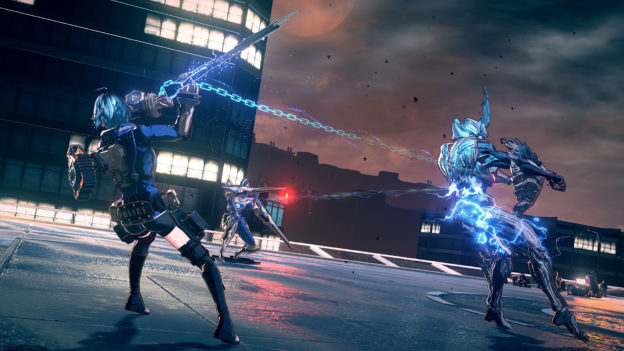
The setting is years in the future where the Earth has been invaded by an interdimensional race of creatures called Chimeras. These creatures have corrupted almost every portion of the planet and now human survivors are forced to retreat to a man-made island called the Ark. In order to combat the Chimera menace, humanity creates an elite police task force called Neuron. As a rookie officer for Neuron, you are given control of a device dubbed the Legatus Unit that also houses Legion, which can be best described as a living weapon. Legions are essentially captured/semi-domesticated Chimeras that will fight alongside you when summoned in battle. These interdimensional creatures are tethered to your Legatus device and can be controlled simultaneously which in turn can lead to some incredible and neon-filled combos.
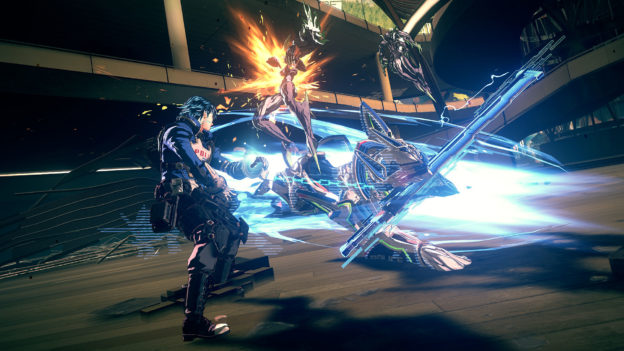
Aside from the up-to-five Legions you will be able to control throughout the main adventure, you will also play as either one of the male or female Howard twins who are embarking on their rookie mission. Whether you choose the sister or brother, the opposite will be fully voiced whereas your choice (aside from a few grunts and such) will be a silent protagonist throughout the entire game. This choice to make your playable character silent isn’t a total negative in any way as I have enjoyed my fair share of customizable protagonists who don’t speak. However, when the plot involving the Howard twins, their father (a veteran Neuron officer), your fellow members of Neuron, and their journey to end the Chimera threat gets into the thick of things, the emotional beats tend to lack any oomph. That is, when your character is just pantomiming their thoughts or nodding their head during vital moments in the story, it just doesn’t resonate as well. Yes, this is fairly common, but it would have been interesting to see the Howard sibling you choose fully fleshed out with a voice. Regardless, it’s a small complaint, but at least the customizable options are still there to make your Neuron avatar whichever way you want.
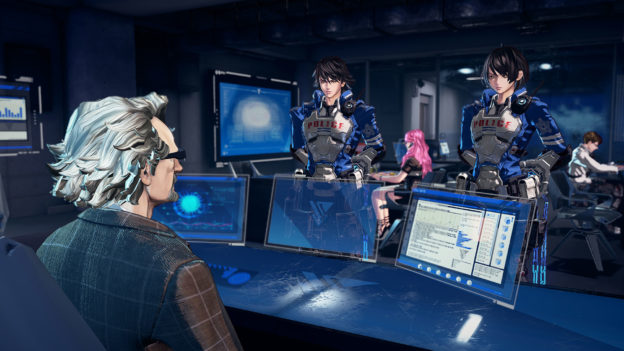
In addition, there are various costumes and accessories to unlock based on how high your rank is or how well you do in varying missions. As for the rest of the cast of characters, they aren’t half bad. The same goes for the overall arc of the game even if it’s par for the course for the occasional silliness you’d see in Platinum’s titles. Moreover, the various officers that make up Neuron have their own great set of personalities, so whenever you have downtime in the HQ you may find yourself chit-chatting with anyone you can.
The combat of Astral Chain can be best described as a symphony of tag team chaos, or Synergetic Action as PlatinumGames likes to officially call it. Now, aside from your chained Legion, you have your own personal arsenal that includes an X-baton, laser pistol, and a long-range sword. Your X-baton and blaster attacks are mapped to the ZR trigger whereas you can summon your Legion with the press of the ZL trigger and dismiss it with the right bumper. Your baton and laser are what will get the most use against multiple Chimeras based on their versatility, but the sword (which in this case is just a long one-handed baton) always comes in handy against much bigger foes.
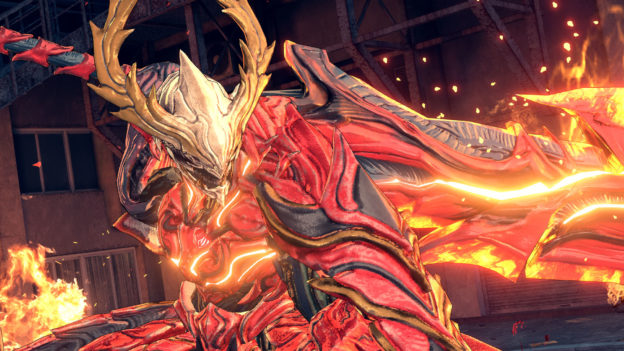
The various Legions you can use come in five varieties: sword, archer, arms, beast, and axe. The sword and archer Legions are where you may get the most use in combat in terms of flexible maneuvers, but the other options do have a lot to offer. While four of the Legions are simply floating humanoids, the beast legion is quadrupedal, a canine that you can also ride. This makes some major boss battles easy to evade at times. Plus, it’s fun and satisfying knowing you have your own canine Legion companion that you can use to sic on enemies with the quick trigger press. When a Legion is out and about, you also have access to its secondary ability. These include like accessing the Sword Legion’s slash ability to cut through barriers and severe the links between Chimera shields or commandeering the Arm Legion to become one powerful entity. In addition, Legions can be used to hop over crevasses by sending them to one spot as far as the chain allows them and with one press you’ll be flicked to their location. It’s rather useful and comes in handy when solving different yet small platforming puzzles.
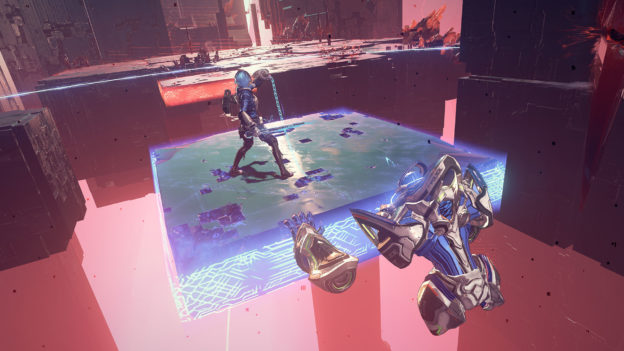
Coordinating your attacks with your Legion can be smooth but tricky. When engaged in battle with one or more Chimeras, the back of your Legatus will light up, indicating that you may perform a sync attack. Much like Bayonetta’s Witch Time ability, sync attacks are extremely helpful when dealing with various Chimeras. Once your Legatus lights up blue, that’s your cue to summon your Legion. If done correctly, you and your Legion will use the titular astral chain (the blue chain used to tether your Legion) to chain bind or combo an enemy. There are also chain counters, which can be used to send oncoming enemies flying into the air. Sticking to one Legion may get tiring for some, but luckily switching between them all is fast and easy with the press of the Y button. You can either quickly zap through Legions with one quick press or hold the Y button to pause the action to switch to the one you desire. But, there is a caveat to having a powerful weapon like Legion; there’s a limit to how long you can keep them out. When you have summoned your Legion in any fashion, a small counter will start to deplete. If it hits zero, your Legion will disappear and be unavailable until the gauge refills. In the end, it makes sure that you are keeping a strict eye on how much combat is too much for your Legion.
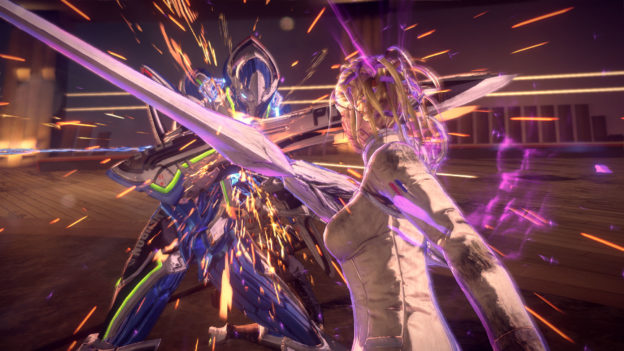
These combat setups are surprisingly simple and intuitive, which alleviated the previous worry of this high-concept combat becoming overly clunky or frustrating. Although, if you do find yourself in a bind in not getting comfortable with the combat and want to better synchronize your Legion or melee attacks, there’s thankfully an in-depth training room at Neuron HQ. Plus, if you find yourself uncomfortable with how you are using your Legion attacks or hitting the wrong buttons you can easily mix things up by fiddling with the default control scheme. The customization here is friendly enough to help those (including myself early on in my playthrough) find the right groove to get into when you want to dispose of Chimeras swiftly and easily.
Aside from your trusty Legatus device from Neuron, there’s also the IRIS interface which acts as an augmented reality interface. The IRIS system can be activated anytime with the press of the plus button. When turned on, the IRIS system will display case locations, people of interest, the names, birthdays, and even blood type of strangers along with where a Legion can use their various skills on certain people or objects. For instance, with IRIS activated you can see if citizens are experiencing red shift (when a person is slowly being corrupted by Chimeras) and have the Sword Legion use blue shift to cure them of the illness. Another scenario also has your Beast Legion able to dig through dirt patches for items or clues or scents. Much like the detective mode used in the Arkham series, having the IRIS interface on at all times is very helpful and makes identifying your next objective easier. In a way, the interface itself kinda mixes what you’d see in a movie like Minority Report or see in some Orwellian dystopia. Whatever the comparison, the IRIS system is just another great feature to go alongside the brightful and frenzied chaotic battles with Chimeras.
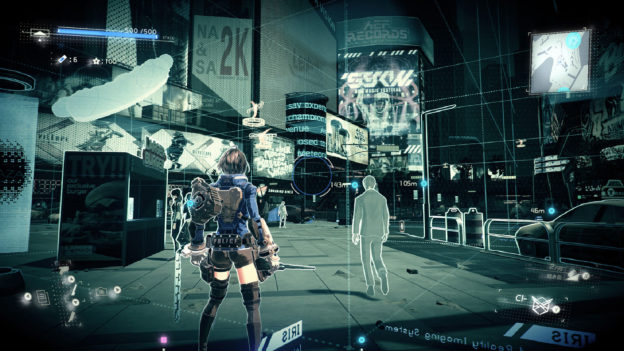
Graphically, Astral Chain looks wonderful on the Switch in handheld or docked mode. The neon-lit colors you see within the Ark or the many battles you face with your Legion are a gorgeous display once in motion; however, within the Chimeras home turf of the Astral Plane, it does seem a tad bland. The drab grayish reds and blacks of the world almost seem like an inverse of the Shrines you’d see in Breath of the Wild. It’s not that they are terrible graphically but rather boring as you spend more and more time in the Astral Plane. Either way, exploring the Astral Plane when forced to has its positives even if its presentation gets old quickly. Thankfully, this plane of existence is a good place where you can test out each of your Legion’s differing abilities when faced with an obstacle.

When you aren’t battling Chimeras you will find yourself solving cases throughout the city and beyond. Some of these cases, which are labeled red cases, involve defeating groups of Chimera or investigating crimes pertaining to the main story. Some investigative work will have you talking to citizens or fellow Neuron officers to collect key words or phrases to then be answered when solving a case. Various red cases may also have you stopping an unsuspecting perp in their tracks by using a Legion’s bind ability. And then there are the blue cases, which are basically the sidequests within each of the game’s 10-plus chapters. These cases are usually easy to find or easy to forget if you don’t have your IRIS always turned on, but they can be good ways to earn a better rating at the end of each chapter. Some blue cases will have you carrying boxes for a person in need or carefully balancing an ice cream cone with multiple scoops to a needy child. Other blue cases may have you helping a mother find her lost child on the streets or just rescuing a stray cat. It may seem like padding for the game’s length, but I found myself trying to complete as many of these tasks as possible before heading back into the fray. These blue cases have their own quirks and charms that break up the frantic action with a much-needed breather.
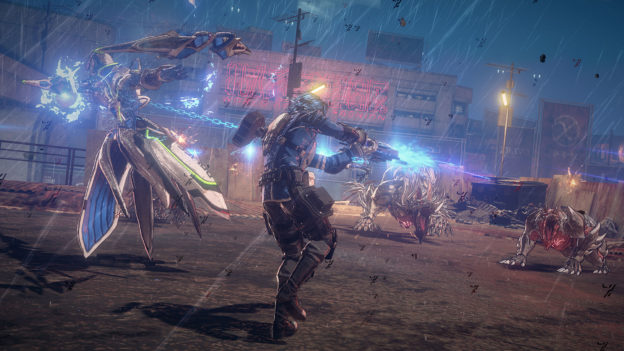
Astral Chain certainly had a lot riding on its unique combat system and whether or not it would work seamlessly or feel gimmicky. I for one had some doubts, but honestly PlatinumGame really outdid themselves by adding yet another banger of a title to their portfolio. After over 20 hours of frenzied combat, slicing and dicing up dozens upon dozens of Chimera foes, exploring and interacting at the Neuron HQ, and solving red and blue cases with the aid of the heavily engaging IRIS interface, there was never a moment that stalled or diluted my enjoyment. The coordinated combat is fun and fluid once adjusted to, and even the slower moments are worthwhile to break away from the usual chaos. Overall, Astral Chain shows us how to extend the action genre with both style and substance.
Review: Astral Chain (Nintendo Switch)
Great
Astral Chain is a wonderfully fun and ambitious action title with a great gameplay hook that improves the more you master the basics. It’s yet another example of why PlatinumGames continues to be one of the best in crafting a unique action-adventure hack-and-slash.


